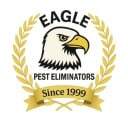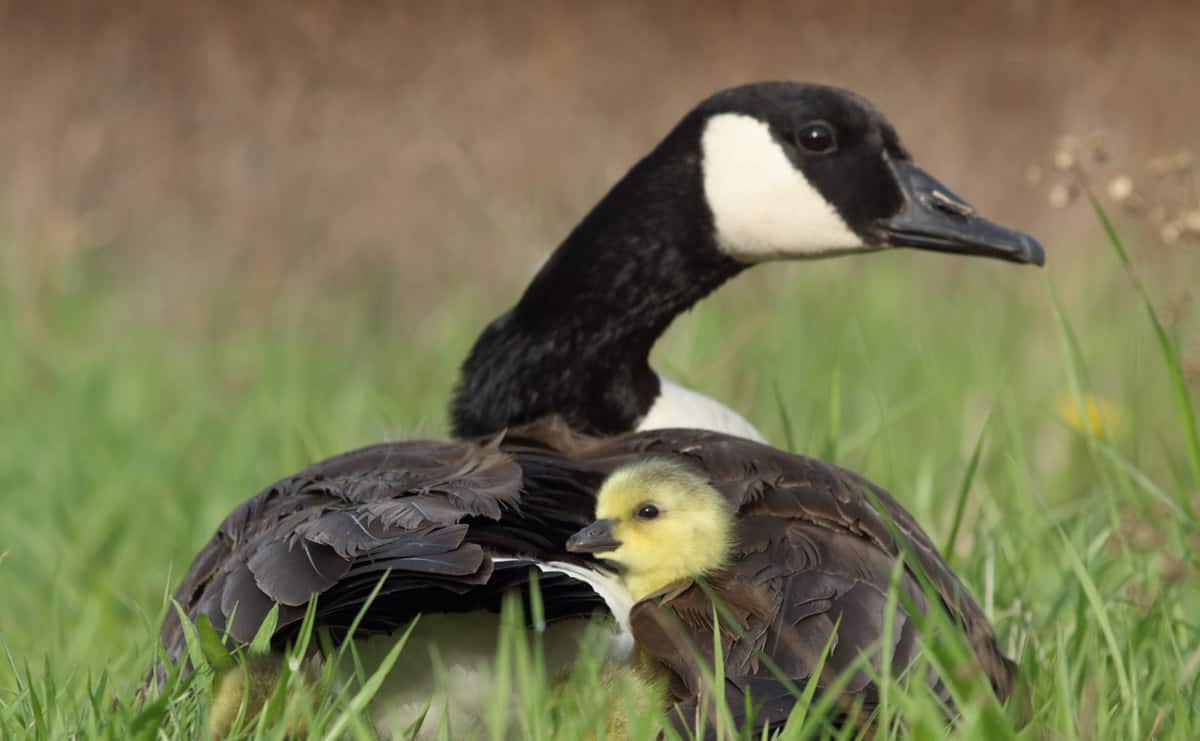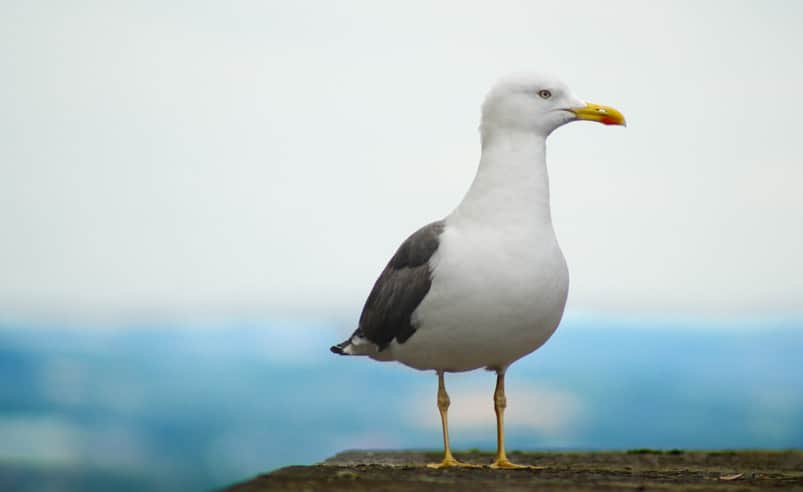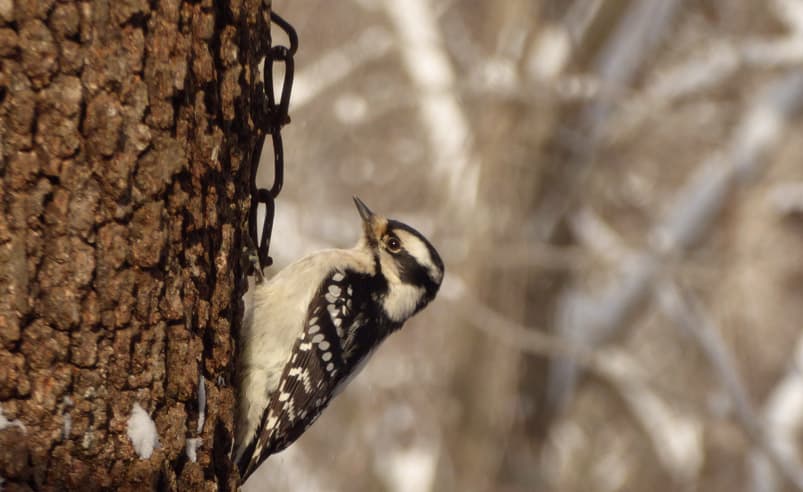Seattle Bird Control
Nesting, Vent Screening & Woodpecker Damage
Homeowner’s Guide to Managing Nuisance Birds
Every year you might have a variety of different kinds of birds trying to nest in your home. One main area birds (starlings) like to nest is in your attic by way of entering the roof eave vents. Be sure you have secured screening or ¼ inch hardware cloth at all roof eave vents. Another type of bird that can damage your home’s wood siding is pileated woodpeckers or flickers. You may need to call in the Professionals, Eagle Pest Eliminators, to do this tough job.
Across Seattle, starlings often enter attic eave vents and woodpeckers can damage siding. Our Seattle pest control team installs screening, repairs access points, and deploys humane deterrents.
General Description
The European Starling is a medium-sized black songbird with spotted plumage and short triangular wings. During breeding season, adults display purple-green iridescence with a pointed yellow bill, while non-breeding adults have darker bills with lighter spotting. Juveniles appear gray-brown overall. Both sexes look similar.
Habitat & Seattle Impact
European Starlings thrive in human-altered environments, making Seattle homes and businesses common targets. They often forage in lawns, agricultural fields, and developed areas, but require nearby nesting cavities—commonly found in attic vents, building eaves, and roof gaps. In urban Seattle, large starling flocks create noise, droppings, and property damage, while also competing with native birds for nesting sites.
Behavior
Starlings form flocks year-round, with massive groups in fall and winter across the Puget Sound. They aggressively harass other birds to take over nesting cavities and are notorious for mobbing predators. In Seattle neighborhoods, they frequently invade vents and rooftops, becoming a persistent nuisance that requires professional bird control services.
Diet
Starlings are opportunistic feeders, consuming insects, berries, seeds, and grains. Around Seattle, they are commonly seen raiding backyard feeders, creating mess and driving away native bird species.
Nesting
These cavity nesters occupy old woodpecker holes, roof eaves, and man-made structures. Seattle homeowners often discover them in attic vents or building crevices. Their nests—made of twigs, grass, feathers, and debris—clog ventilation and cause sanitation concerns. A pair can produce multiple broods per season, quickly leading to infestations.
Migration & Local Status
In Washington, European Starlings are partially migratory, shifting into valleys and urban areas such as Seattle during winter. Since first arriving in Washington in 1943, they’ve become one of the state’s most abundant nuisance birds, now considered an invasive species with a strong negative impact on native cavity-nesting birds.
Seattle Bird Control Solutions
If you’re dealing with starling problems in Seattle, Eagle Pest Eliminators provides humane, effective bird control services. From attic vent screening to exclusion netting and safe deterrent methods, our team protects homes, storefronts, and commercial properties from starling infestations. Call our Seattle office at (206) 365-4480 or Everett at (425) 398-7365 for fast, reliable service.
Rock Pigeons, commonly called “pigeons,” are one of the most familiar birds in Seattle and urban areas worldwide. These chunky gray birds with sharply pointed wings often show black wing bars, red eyes, and salmon-colored feet. Their plumage varies, but gray with darker markings is most common.
Habitat & Seattle Impact
Originally cliff-nesters, Rock Pigeons thrive in Seattle’s urban environment. They roost on ledges, bridges, attics, warehouses, and rooftops, leaving behind droppings that damage buildings, signage, and vehicles. Around Seattle’s downtown core and commercial districts, pigeons are among the most persistent nuisance birds, creating sanitation hazards for businesses and residents.
Behavior
Pigeons are fast fliers and gather in flocks, often seen along utility wires, window ledges, and rooftops in Seattle neighborhoods. Large groups produce noise, droppings, and unsanitary buildup, requiring professional bird control services to deter them effectively.
Diet
In cities like Seattle, Rock Pigeons feed on discarded food such as bread and popcorn, in addition to grains and seeds. Their reliance on human food sources makes them highly adaptable but also reinforces their presence in commercial zones and residential areas.
Nesting
Pigeons frequently nest on ledges, beams, and covered flat surfaces of Seattle buildings, bridges, and parking garages. Because nests are reused and added to with each brood, infestations can grow quickly—pairs may raise 5 or more broods annually. Nesting debris clogs drainage systems, while droppings create slip hazards and health concerns.
Migration & Local Status
Rock Pigeons are non-migratory. Once established in a Seattle building or structure, they return repeatedly thanks to their strong homing ability. This makes prevention and exclusion essential.
Seattle Bird Control Solutions
While pigeons are a part of city life, uncontrolled populations pose serious risks to health, safety, and property. Eagle Pest Eliminators provides humane, effective pigeon control in Seattle, including exclusion netting, spike installations, and safe deterrents to protect homes, storefronts, warehouses, and public spaces. Call our Seattle office at (206) 365-4480 or Everett at (425) 398-7365 to schedule an inspection and keep your property bird-free.
General Description
The familiar House Sparrow is a chunky sparrow with a large head and short tail. It was introduced to this country from Europe and is in a different family from our native sparrows. Males in breeding plumage have streaked chestnut backs, chestnut heads, and gray crowns. They have black throats and breasts and light gray cheeks and under parts. Males in non-breeding plumage look similar, but lack the black throat and breast, have less distinct markings on their heads, and have yellowish rather than black bills. Females have drab, grayish-brown, unstreaked breasts, with mottled buff and brown upperparts and light eye-stripes.
Habitat
House Sparrows are closely tied to areas of human habitation, in either urban or rural settings. They can survive on city sidewalks or in farmlands, but avoid extensive woodlands, native grasslands, and deserts away from human development.
Behavior
House Sparrows form large flocks throughout the state, but tend to gather in larger flocks in the eastern part of Washington. They forage while hopping on the ground, at feeders, or by perching on weed stalks. These sparrows are opportunistic and eat whatever is available. While they are not highly territorial with their own species, they are aggressive toward other species and may drive native birds out of their nests.
Diet
House Sparrows are primarily seedeaters but also eat insects, especially during the breeding season. In agricultural areas, waste grain is an important diet component. Urban House Sparrows live off crumbs and rubbish left by humans.
Nesting
House Sparrows are monogamous and typically breed in cavities. They will use crevices in buildings, nest boxes, or other birds’ nests, but if they are in an area with no available cavities, they nest in trees or shrubs, often in small colonies. Both sexes help build the nest, which is a globular nest of twigs, grass, and weeds, often lined with feathers. If the nest is in a cavity, the nesting material generally fills the volume of the cavity. Both parents help incubate 3 to 6 eggs for 10 to 14 days, and both feed the young. The young leave the nest after about two weeks. They stay nearby for 7 to 10 days and then flock with other juvenile birds. The pair raises 2 to 3 broods each year.
Migration Status
House Sparrows are permanent residents throughout North America.
Conservation Status
House Sparrows are one of the most abundant and widespread songbirds in the world. They were originally introduced in this country to control caterpillars. They were first released in New York in 1851, and again in 1852. They were also released in San Francisco in 1871, 1872, and in Salt Lake City in 1873, 1874. House Sparrows were first noted in Spokane in 1895, made it to Seattle by 1897, and to the coast at La Push by 1916. In urban areas, they inhabit a niche not used by native birds, but in agricultural areas they compete with native birds for limited nesting cavities and may affect local populations.
When and Where to Find in Washington
House Sparrows are abundant year round in human-inhabited areas throughout Washington.
General DescriptionThe Northern Flicker is one of the most common woodpeckers in Seattle and throughout Washington. Unlike most woodpeckers, their overall coloration is brown rather than the typical black and white. Red-shafted Flickers are most common in our region, showing reddish-orange flight feathers, gray heads, and red “moustache” marks in males. Yellow-shafted Flickers are less common in Seattle but appear during winter migration, displaying yellow flight feathers and red nape crescents.
Habitat & Seattle ImpactNorthern Flickers thrive in Seattle’s residential areas, parks, and gardens, where they often forage on lawns and nest in cavity spaces. While they are valuable for ecosystems, they can become a serious nuisance when they drill into siding, attics, or wooden structures around homes and businesses. Their loud drumming on buildings during mating season is a frequent complaint from Seattle property owners.
BehaviorUnlike most woodpeckers, Flickers spend much of their time foraging on the ground for ants and insects. In Seattle neighborhoods, they are easily recognized by their undulating flight, prominent white rump, and loud “whinny” calls. Persistent drumming on wood or metal surfaces can damage siding, shingles, and chimney caps.
DietFlickers primarily feed on ants but also consume other insects, seeds, berries, and fruit. Around Seattle, they are often seen probing lawns for ants or feeding in berry bushes in city parks.
NestingNorthern Flickers excavate cavities in trees but frequently use structures in suburban Seattle when natural sites are unavailable. They may nest in attics, vents, or siding gaps, leaving behind noise and structural damage. Pairs typically raise 5–8 chicks, and nesting sites are reused or expanded over time, worsening the problem if not addressed.
Migration & Local StatusIn western Washington, Red-shafted Flickers are common year-round, while Yellow-shafted Flickers arrive in greater numbers during winter. Seattle residents most often encounter them in the lowlands during fall and winter, when food sources are abundant.
Seattle Bird Control SolutionsWhile Flickers are a protected species and play an important ecological role, they can’t be allowed to damage buildings. Eagle Pest Eliminators offers humane, effective bird control solutions in Seattle to deter Northern Flickers from pecking on homes and commercial properties. We install deterrents, protective screening, and safe exclusion methods to prevent costly structural damage while keeping birds unharmed. Call our Seattle office at (206) 365-4480 or Everett at (425) 398-7365 to schedule a bird control inspection today.
General DescriptionThe Pileated Woodpecker is the largest woodpecker in North America, recognizable by its crow-like size and striking red crest. Males show red moustache stripes while females have black, and both sexes display bold white stripes along the neck. In flight, white underwing linings and flashes at the wrist stand out. These dramatic birds are impressive to see, but when they drum or excavate around homes and businesses in Seattle, they can cause significant structural damage.
Habitat & Seattle ImpactPileated Woodpeckers thrive in forests with large trees, including western hemlock and western red cedar. In western Washington, they are increasingly found in Seattle’s city parks and residential neighborhoods with mature trees. While they play an important ecological role, they are also known to damage siding, utility poles, and wooden structures when searching for carpenter ants or excavating nest cavities.
BehaviorThese woodpeckers create large oval or rectangular holes in trees, and their loud drumming and “laughing” call can carry long distances. In Seattle neighborhoods, they sometimes choose building exteriors, sheds, or garages as drumming sites, leading to persistent noise and property damage.
DietPileated Woodpeckers feed primarily on carpenter ants and wood-boring beetles, but also consume fruit and nuts. Their preference for carpenter ants often draws them close to homes in Seattle where ant infestations are present.
NestingPairs stay together year-round, excavating new nest cavities each season in dead or dying trees. While natural cavities benefit many species, in urban Seattle, this behavior often translates to holes in utility poles, siding, or large backyard trees, requiring professional intervention.
Migration & Local StatusPileated Woodpeckers are generally year-round residents in western Washington. In Seattle, they can be found in parks like Discovery Park, Seward Park, and Camp Long, as well as in mature residential areas.
Seattle Bird Control SolutionsAlthough Pileated Woodpeckers are a protected species, they can still cause extensive damage to homes and businesses. Eagle Pest Eliminators offers humane bird control solutions in Seattle that deter woodpeckers safely, protecting siding, chimneys, and wooden structures from costly repairs. Our team uses exclusion methods and deterrent products designed to move woodpeckers away without harm. Call our Seattle office at (206) 365-4480 or Everett at (425) 398-7365 to schedule a bird control inspection today.
General DescriptionA well-known and easily distinguished bird, the Canada Goose has a mottled gray-brown body, black legs, tail, neck, head, and face, with a white rump, sides, and chin-strap. There are a number of recognized subspecies that vary considerably in size. Some of the smaller subspecies have a white ring at the base of the neck.
HabitatAlways found near water, Canada Geese inhabit lakes, ponds, bays, marshes, yards, and fields. Urban populations are not shy around people and often live in city parks and suburban ponds.
BehaviorCanada Geese graze while walking on land, and feed on submergent aquatic vegetation by reaching under the water with their long necks. Males defend territories from other geese and humans by hissing.
DietAquatic plant material and waste grain left in plowed fields make up the majority of the Canada Goose’s diet. Insects, mollusks, crustaceans, and occasionally small fish are also eaten.
NestingCanada Geese form long-term pair bonds. The female chooses the nest-site on a slightly elevated spot near water with good visibility. She then builds the nest, a shallow bowl with a slight depression, made of sticks, grass, and weeds, and lined with down. She lays and incubates 4 to 7 eggs, while the male stands guard nearby. One or two days after the young hatch, they swim and feed themselves, although the parents still tend them and help them find food. The young first fly at 6 to 9 weeks depending on the race.Migration StatusHistorically, each population of Canada Goose followed a rigid migratory corridor with traditional stopovers and wintering areas, like most other North American geese. Today, however, many urban populations are year-round residents, and other populations have changed migratory routes.
Conservation StatusConservation of Canada Geese is complex since some of the seven subspecies are so abundant that they are controlled as nuisances and other subspecies are considered endangered. One subspecies of Canada Goose (Branta canadensis moffitti) breeds in Washington. This subspecies is common year round in developed areas, especially grassy waterfront lawns. These geese were uncommon here before 1900, but as habitat has been altered by humans, stricter hunting laws enforced, and natural predators eliminated, their population has grown. In the Seattle area, many people consider Canada Geese a nuisance. Within the past few years, control measures have included egg shaking and oiling, relocating, and even killing large numbers of geese. These stopgap measures, however, only temporarily reduce the urban populations, which rebound as long as they have abundant habitat and food.
When and Where to Find in WashingtonResident Canada Geese can be found throughout Washington’s lowlands in wetlands and waterways, especially in city parks and agricultural areas. As residents they seem to be absent from the Olympic Peninsula and the outer coast north of Grays Harbor and east of Cape Flattery to Port Angeles. West of the Cascades they are common year round. East of the Cascades they are common from October to mid-April and uncommon the rest of the year. Aleutian Canada Geese can be found stopping over at Willapa National Wildlife Refuge and on fields near Willapa Bay during migration, from September to the end of November. Northward migrants also stop in this area between February and March, but not generally in such large numbers. The entire population of the Dusky Canada Goose, another subspecies, winters along the Columbia River Valley and the adjacent Willamette River Valley at the Ridgefield National Wildlife Refuge (Clark County), where up to seven different races can be seen.
Seagulls are a common sight around Seattle’s waterfront, parks, and commercial districts, but when they gather in large numbers, they quickly become a nuisance. Droppings damage roofs, signage, and vehicles, while constant noise and aggressive behavior create health and safety concerns for businesses and homeowners alike.
Eagle Pest Eliminators provides humane, effective seagull control solutions in Seattle. Our team uses proven deterrents, exclusion methods, and safe products to keep seagulls away from rooftops, parking lots, warehouses, and residential properties. Whether you’re dealing with messy roosting areas or repeated flock activity near your home or business, we can help protect your property and restore peace of mind. Call our Seattle office at (206) 365-4480 or Everett at (425) 398-7365 for a free consultation on professional seagull control.
130+ Reviews, avg 4.7 stars
Get A Quote Today
When you contact us for an estimate, our certified technicians will inspect your home and provide you with a detailed plan to eliminate those unwanted invaders. They will also discuss treatment options to ensure you are informed before they take any action.
Call our Seattle office at (206) 365-4480 or Everett office at (425) 398-7365 for rodent control you can trust. Eagle Pest Eliminators has protected Seattle & Everett homes and businesses from rats and mice since 1999.







